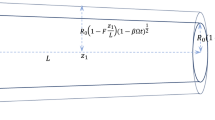Abstract
Based on experimental measurements of femoral arterial blood pressure and flow and the assumption that for peripheral haemodynamics the vascular bed can be lumped into functional sections, the effect of the small arterial region on femoral artery blood pressure-flow dynamics has been formulated. An analogue computer model has been developed to represent the dynamics for both pulsatile as well as non-pulsatile components of pressure and flow. Each section of the model has been identified with definite physiological analogue. The performance of the model corresponds closely to experimental data obtained from the dog, both for normal situations as well as for induced vasoconstriction and vasodilatation. Therefore the conclusion has been drawn that the assumptions made are empirically valid and the model can be used to describe the role of the small arterial region in peripheral haemodynamics.
Sommaire
Des mesures expérimentales de la pression et du courant sanguin dans l'artère fémorale et la supposition que pour l'hémodynamique périphérique le vit vasculaire peut être imaginé d'exister en sections fonctionnelles, ont permis de formuler l'effet du réseau des petites artères sur la dynamique pression-courant sanguin dans l'artère fémorale. Un modèle a été developpé en utilisant un calculateur analogique, représentant les relations dynamiques des composantes pulsatiles et non-pulsatiles de la pression et du courant sanguin. Chaque section de ce modèle représente un analogue physiologique bien déterminé. Les résultats obtenus avec ce modèle correspondent de près aux résultats expérimentaux obtenus sur un chien, dans les circonstances normales et en états de vasoconstriction et vasodilatation provoquées. De ce fait on peut tirer la conclusion que nos suppositions sont empiriquement valables et que notre modèle peut être e mployé pour définir le rôle du réseau des petites artères dans l'hémodynamique périphérique.
Zusammenfassung
Auf Frundlage experimenteller Messung von femoralem arteriellen Blutdruck und Strom, und der Annahme, daß für peripherische Hämodynamik das Gefäßbett etwa in funktionelle Teile zerlegt werden kann, wurde die Wirkung des Gebietes der kleinen Arterien auf femorale Arterienblutdruck-Strom-Dynamik formuliert. Ein Modell für einen Analogrechner wurde ausgearbeitet, um die Dynamik für pulsierende wie auch nicht-pulsierende Komponenten des Druckes und Stromes darzustellen. Jeder Teil des Modelles wurde bestimmten physiologischen Analogen gleichgesetzt. Die Leistung des Modelles steht in engem Einklang mit experimentellen Daten die vom Hund erhalten wurden, sowohl für normale Situationen als auch für induzierte Gefäßeinengung und Gefäßerweiterung. Deshalb wurde der Schluß gezogen, daß die Annahmen die gemacht wurden, empirisch gültig sind und das Modell dazu benützt werden kann, die Rolle des Gebietes der kleinen Arterien in peripherischer Hämodynamik zu beschreiben.
Similar content being viewed by others
References
Attinger, E. O. (1968) Pulsatile blood flow analysis. InAdvances in Biomedical Engineering and Medical Physics (Ed.S. Levine). Wiley, New York.
Guha, S. K. andRichardson, A. W. (1965) Phase sensitive detector type electromagnetic flowmeter.J. appl. Physiol. 20 (5), 1085–1087.
Guha, S. K. (1966) Special physiologic factors in the dynamics of blood circulation in the dog. Ph.D. Thesis, St. Louis University.
Hara, H. H. (1962) Analogue computer simulation of human blood circulation.Proc. San Diego Symp. Biomed. Engng 2, 107.
McDonald, D. A. andTaylor, M. G. (1959) The hydrodynamics of the arterial circulation.Prog. Biophys. biophys. Chem. 9, 105–173.
Noordergraaf, A., Verdouw, P. P. andBoom, H. B. K. (1963) The use of an analogue computer in a circulation model.Prog. cardiovasc. Dis. 5, 419.
Noordergraaf, A., Verdouw, P. D., Brummlen, A. G. W. V. andWiegel, F. W. (1964) Analogue of the arterial bed. InPulsatile Blood Flow, pp. 373–381 (Ed.E. O. Attinger). McGraw-Hill, New York.
Ralston, A. andWilf, H. S. (1960)Mathematical Methods for Digital Computers. Wiley, New York.
Rothe, C. F. andNash, F. D. (1968) Renal arterial compliance and conductance measurement using online self-adaptive analogue computation of model parameters.Med. biol. Engng 6, 53–69.
Warner, H. R. (1962) Use of analogue computer in the study of control mechanism in the circulation.Fedn Proc. Symp. 21, 87.
Author information
Authors and Affiliations
Rights and permissions
About this article
Cite this article
Guha, S.K. Haemodynamics of the small arterial region in the femoral vascular bed. Med. & biol. Engng. 8, 291–299 (1970). https://doi.org/10.1007/BF02477246
Received:
Issue Date:
DOI: https://doi.org/10.1007/BF02477246




